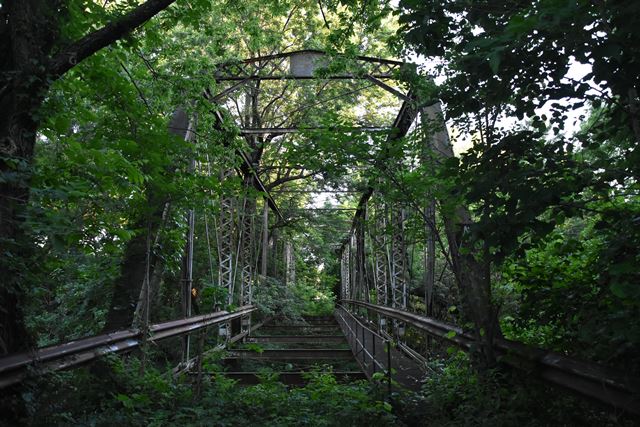We Recommend:
Bach Steel - Experts at historic truss bridge restoration.
BridgeHunter.com Phase 1 is released to the public! - Visit Now
Mill Creek Bridge

Primary Photographer(s): Nathan Holth
Bridge Documented: June 5, 2016
Fort Scott: Bourbon County, Kansas: United States
By Builder/Contractor: Unknown
Not Available or Not Applicable
Not Available
Not Available
Not Available
1 Main Span(s)
Not Applicable

View Information About HSR Ratings
Bridge Documentation
This bridge no longer exists!
Bridge Status: This historic bridge has collapsed, as of 2021 the parts still remain in the river.This mysterious bridge has an unknown history. It appears to be a bridge that a long time ago (decades ago, in the riveted era at least) was completely put together from a wide variety of other bridge parts. It is not known if the bridge is 100% spare parts, or if its part of an original bridge at this location that was altered for some unknown reason. Some of the channels on this bridge have the name Union Iron Mill of Buffalo, New York. Iron from this mill tends to show up on old bridges from the 1870. So at least some of the parts on this bridge may be very old.
What is remarkable is how inconsistent the vertical members on this bridge are, including lack of concern for proper engineering design. From north to south the verticals are as follows. Hip Vertical: Paired eyebars with wood stiffener jammed in. The use of eyebars at the hip vertical is not unusual. The next four verticals are large built-up members with back-to-back channels and v-lacing on each side. The v-lacing is traditional bar with rounded ends. The next two verticals defy basic engineering practice as they are paired eyebars. Even with the wooden stiffeners jammed in between each pair, the compressive forces have buckled the eyebars. The next two verticals are built-up members with back-to-back channels and v-lacing on each side. However, the design is different from those at the north end of the bridge, as the spacing between the two channels is much less (giving the v-lacing a narrower look). Also, the v-lacing on these members do not have the typical rounded ends, and are instead cut at straight angles.
The overhead bracing used on this bridge was originally designed for a narrower roadway; the struts (sway bracing) and portal bracing on this bridge are shorter than they should be. As a result, in order to fit them to the bridge, little pieces of plate were placed on top of the top chord, extending over the roadway. It is on these plates that the portal bracing and struts rest. This odd design has not fared well, and the plates are badly deteriorated. Additionally, empty rivet holes were noted on the underside of the portal bracing. These would suggest the original location of knee bracing connections for whatever bridge these portal braces were originally on.
The floorbeams for this bridge have notches for two u-bolt hangers at each end, but only a single u-bolt hanger is present, and as currently assembled, there is not any room for a second hanger on the bottom chord pins, as there are eyebars taking up the space.
Even diagonal members are inconsistent... more than one turnbuckle design can be found among the counter diagonals on this bridge.
The history of this bridge is totally unknown, but it is no doubt an interesting story if anyone could figure out what the story is.
![]()
Photo Galleries and Videos: Mill Creek Bridge
Bridge Photo-Documentation
Original / Full Size PhotosA collection of overview and detail photos. This gallery offers photos in the highest available resolution and file size in a touch-friendly popup viewer.
Alternatively, Browse Without Using Viewer
![]()
Bridge Photo-Documentation
Mobile Optimized PhotosA collection of overview and detail photos. This gallery features data-friendly, fast-loading photos in a touch-friendly popup viewer.
Alternatively, Browse Without Using Viewer
![]()
Maps and Links: Mill Creek Bridge
This historic bridge has been demolished. This map is shown for reference purposes only.
Coordinates (Latitude, Longitude):
Search For Additional Bridge Listings:
Bridgehunter.com: View listed bridges within 0.5 miles (0.8 kilometers) of this bridge.
Bridgehunter.com: View listed bridges within 10 miles (16 kilometers) of this bridge.
Additional Maps:
Google Streetview (If Available)
GeoHack (Additional Links and Coordinates)
Apple Maps (Via DuckDuckGo Search)
Apple Maps (Apple devices only)
Android: Open Location In Your Map or GPS App
Flickr Gallery (Find Nearby Photos)
Wikimedia Commons (Find Nearby Photos)
Directions Via Sygic For Android
Directions Via Sygic For iOS and Android Dolphin Browser
USGS National Map (United States Only)
Historical USGS Topo Maps (United States Only)
Historic Aerials (United States Only)
CalTopo Maps (United States Only)

